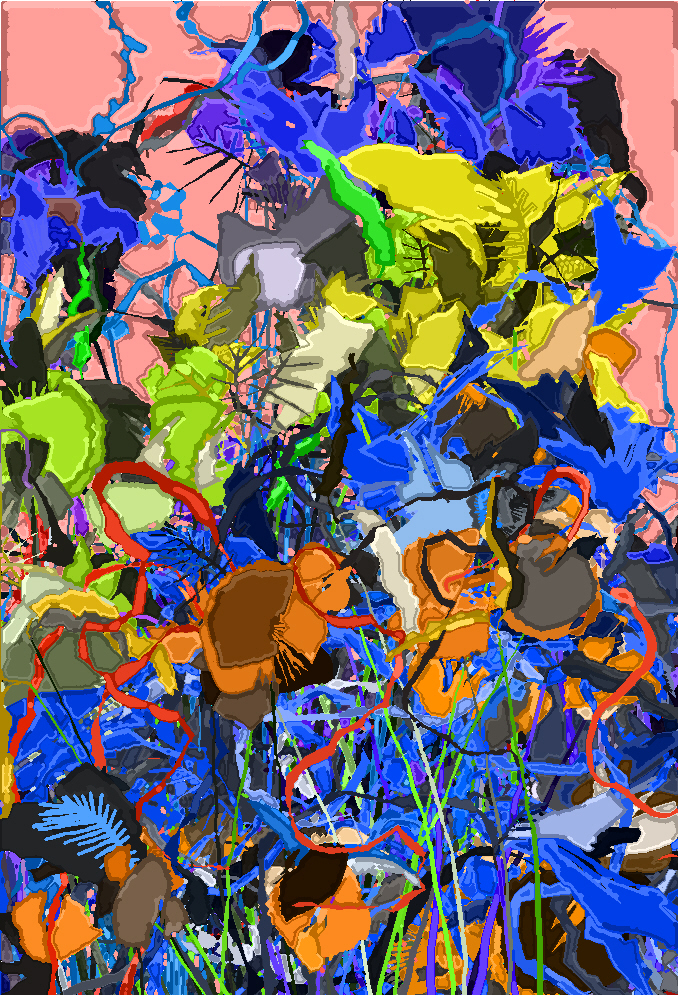Artist Harold Cohen's 'Collaborations with My Other Self' Opens at gallery@calit2
San Diego, Calif., Oct. 27, 2011 -- Harold Cohen’s ‘other self’ can draw leaf clusters ad infinitum, but has no idea what a plant actually looks like. It can draw a wide range of human figures, but lacks corporeality of its own.
|
That’s because Cohen’s ‘other self’ isn’t a self at all, but a computer program known as AARON. An ongoing research effort in autonomous machine (art making) intelligence, AARON has been Cohen’s life-work for more than 40 years, from his stint as a visiting scholar at Stanford University’s Artificial Intelligence Laboratory in the early 1970s through a one-year Visiting Professorship at the University of California, San Diego, that later morphed into a role as founding director of UCSD’s Center for Research in Computing and the Arts (CRCA).
Cohen is exhibiting a selection of paintings created in collaboration with AARON at the UC San Diego gallery@calit2, which is located in Atkinson Hall at the division headquarters of the California Institute of Telecommunications and Information Technology (Calit2). The exhibition, titled “Collaborations with my Other Self,” opened yesterday and runs through Dec. 9. The opening will be followed by a panel discussion from noon to 2 p.m. Friday, Oct. 28.
Cohen’s continuous work on and with AARON has significantly transformed the typical artist/medium (or programmer/program) relationship for the painter, who originally hails from England. One of the few artists ever to have become deeply involved in artificial intelligence (AI), he began with a strong thrust towards program autonomy, in the course of which AARON became the only program in existence to function as a world-class colorist. Together, Cohen and AARON have exhibited at London's Tate Gallery, the LA County Museum, the Brooklyn Museum, the San Francisco Museum of Modern Art, Amsterdam's Stedelijk Museum, the Museum of Contemporary Art San Diego and many more of the world's major art spaces.
In an interview at his home studio in Encinitas, Cohen remarked that his first forays into programming were characterized by “excitement about a completely different intellectual discipline” compounded with a suspicion that “there must have been more interesting things happening than were going on in my studio.
“I felt as if I was using my brain in a way I’d never been using it before, which was exciting and invigorating,” he added. But eventually he “started to see that actually, this was not only a medium in which one could express rules rather precisely, it was also a medium that could potentially execute the rules once the rules had been stated.”
From that point on, Cohen’s work evolved in tandem with the evolution of computing itself. He estimates that since he began programming in 1968, computing power has doubled 28-fold, resulting in far more powerful and wide-ranging collaborations with AARON over time.
“If you want to remember what computing was like when I got involved in it,” he explained, “you can imagine it as sort of a postage stamp on a football field. That’s how much power we actually had. It’s sort of remarkable that we thought we could do anything with that.”
|
“When I started thinking about color and how a computer program might handle it, trying to do that in the classic AI terms of modeling my own behavior (meant) I was up against a brick wall,” explained Cohen. “Human beings rely absolutely on a refined visual feedback system in order to handle color, and here’s a computer that doesn’t have any visual system at all.”
On the other hand, added Cohen, “human beings actually have almost no color imagination. I can’t say to my assistant, ‘I want this particular color over there, and you want to mix two parts of this and one part of that and put it over there.’ You can’t build an image in your head of color. The computer, on the other hand, could do that perfectly well. So once I’d realized that the thing had to be formulated in the program’s terms, not in my terms, then I was able to make significant progress. The problem fell apart fairly easily, actually.”
Today, Cohen regards AARON as collaborator rather than independent artist. The changing states of this relationship are reflected in the three groups of works in this exhibition, which include works on paper made by AARON and presented as "orthodox" editioned prints, as well as one-off printed images that have then been permanently mounted and surface-treated to function as "paintings." In the most recent work, AARON generates "underpaintings" rather than completed images, printing them on canvas for Cohen to develop by hand. The exhibition also includes a screen-based version of the program in the exhibition, which continuously modifies a single image for the duration of the show.
The work of Cohen and AARON has also been shown at a dozen science centers, including the Ontario Science Center, the Boston Science Museum and the Los Angeles Museum of Science and Industry. Cohen represented the U.S. in the world’s fair in Tsukuba, Japan, in 1985. He has permanent exhibits devoted to his work in the Museum of Computing History in Mountain View, CA, and in the Carnegie Science Center in Pittsburgh.
The gallery@calit2 is open to the public from 11 a.m. to 5 p.m., Monday through Friday. Admission is free.
Media Contacts
Tiffany Fox, (858) 246-0353, tfox@ucsd.edu


